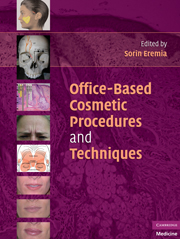Book contents
- Frontmatter
- Contents
- PREFACE
- CONTRIBUTORS
- PART ONE ANATOMY AND THE AGING PROCESS
- PART TWO ANESTHESIA AND SEDATION FOR OFFICE COSMETIC PROCEDURES
- PART THREE FILLERS AND NEUROTOXINS
- PART FOUR COSMETIC APPLICATIONS OF LIGHT, RADIOFREQUENCY, AND ULTRASOUND ENERGY
- Chap. 42 TREATMENT OF TELANGIECTASIA, POIKILODERMA, AND FACE AND LEG VEINS
- Chap. 43 VASCULAR LASERS
- Chap. 44 OVERVIEW OF CO2 AND ER:YAG LASERS AND PLASMA DEVICES
- Chap. 45 CONTEMPORARY CO2 LASER RESURFACING
- Chap. 46 ER:YAG
- Chap. 47 PLASMA SKIN REJUVENATION OF THE HANDS
- Chap. 48 NONABLATIVE LASER TISSUE REMODELING: 1,064-, 1,320-, 1,450-, AND 1,540-NM LASER SYSTEMS
- Chap. 49 OVERVIEW OF BROADBAND LIGHT DEVICES
- Chap. 50 TITAN: INDUCING DERMAL CONTRACTION
- Chap. 51 SCITON BROADBAND LIGHT AND ER:YAG MICROPEEL COMBINATION
- Chap. 52 AMINOLEVULINIC ACID PHOTODYNAMIC THERAPY FOR FACIAL REJUVENATION AND ACNE
- Chap. 53 THERMAGE FOR FACE AND BODY
- Chap. 54 LUMENIS ALUMA SKIN TIGHTENING SYSTEM
- Chap. 55 ELLMAN RADIOFREQUENCY DEVICE FOR SKIN TIGHTENING
- Chap. 56 ALMA ACCENT DUAL RADIOFREQUENCY DEVICE FOR TISSUE CONTOURING
- Chap. 57 COMBINED LIGHT AND BIPOLAR RADIOFREQUENCY
- Chap. 58 FRACTIONAL LASERS: GENERAL CONCEPTS
- Chap. 59 PALOMAR LUX 1,540-NM FRACTIONAL LASER
- Chap. 60 FRAXEL 1,550-NM LASER (FRAXEL RE:STORE)
- Chap. 61 1,440-NM FRACTIONAL LASER: CYNOSURE AFFIRM
- Chap. 62 SCITON ER:YAG 2,940-NM FRACTIONAL LASER
- Chap. 63 ALMA PIXEL ER:YAG FRACTIONAL LASER
- Chap. 64 FRACTIONATED CO2 LASER
- Chap. 65 LED PHOTOREJUVENATION DEVICES
- Chap. 66 PHOTOPNEUMATIC THERAPY
- Chap. 67 HAIR REMOVAL: LASER AND BROADBAND LIGHT DEVICES
- Chap. 68 ACNE AND ACNE SCARS: LASER AND LIGHT TREATMENTS
- Chap. 69 FAT AND CELLULITE REDUCTION: GENERAL PRINCIPLES
- Chap. 70 ULTRASHAPE FOCUSED ULTRASOUND FAT REDUCTION DEVICE
- Chap. 71 LIPOSONIX ULTRASOUND DEVICE FOR BODY SCULPTING
- PART FIVE OTHER PROCEDURES
- INDEX
- References
Chap. 71 - LIPOSONIX ULTRASOUND DEVICE FOR BODY SCULPTING
from PART FOUR - COSMETIC APPLICATIONS OF LIGHT, RADIOFREQUENCY, AND ULTRASOUND ENERGY
Published online by Cambridge University Press: 06 July 2010
- Frontmatter
- Contents
- PREFACE
- CONTRIBUTORS
- PART ONE ANATOMY AND THE AGING PROCESS
- PART TWO ANESTHESIA AND SEDATION FOR OFFICE COSMETIC PROCEDURES
- PART THREE FILLERS AND NEUROTOXINS
- PART FOUR COSMETIC APPLICATIONS OF LIGHT, RADIOFREQUENCY, AND ULTRASOUND ENERGY
- Chap. 42 TREATMENT OF TELANGIECTASIA, POIKILODERMA, AND FACE AND LEG VEINS
- Chap. 43 VASCULAR LASERS
- Chap. 44 OVERVIEW OF CO2 AND ER:YAG LASERS AND PLASMA DEVICES
- Chap. 45 CONTEMPORARY CO2 LASER RESURFACING
- Chap. 46 ER:YAG
- Chap. 47 PLASMA SKIN REJUVENATION OF THE HANDS
- Chap. 48 NONABLATIVE LASER TISSUE REMODELING: 1,064-, 1,320-, 1,450-, AND 1,540-NM LASER SYSTEMS
- Chap. 49 OVERVIEW OF BROADBAND LIGHT DEVICES
- Chap. 50 TITAN: INDUCING DERMAL CONTRACTION
- Chap. 51 SCITON BROADBAND LIGHT AND ER:YAG MICROPEEL COMBINATION
- Chap. 52 AMINOLEVULINIC ACID PHOTODYNAMIC THERAPY FOR FACIAL REJUVENATION AND ACNE
- Chap. 53 THERMAGE FOR FACE AND BODY
- Chap. 54 LUMENIS ALUMA SKIN TIGHTENING SYSTEM
- Chap. 55 ELLMAN RADIOFREQUENCY DEVICE FOR SKIN TIGHTENING
- Chap. 56 ALMA ACCENT DUAL RADIOFREQUENCY DEVICE FOR TISSUE CONTOURING
- Chap. 57 COMBINED LIGHT AND BIPOLAR RADIOFREQUENCY
- Chap. 58 FRACTIONAL LASERS: GENERAL CONCEPTS
- Chap. 59 PALOMAR LUX 1,540-NM FRACTIONAL LASER
- Chap. 60 FRAXEL 1,550-NM LASER (FRAXEL RE:STORE)
- Chap. 61 1,440-NM FRACTIONAL LASER: CYNOSURE AFFIRM
- Chap. 62 SCITON ER:YAG 2,940-NM FRACTIONAL LASER
- Chap. 63 ALMA PIXEL ER:YAG FRACTIONAL LASER
- Chap. 64 FRACTIONATED CO2 LASER
- Chap. 65 LED PHOTOREJUVENATION DEVICES
- Chap. 66 PHOTOPNEUMATIC THERAPY
- Chap. 67 HAIR REMOVAL: LASER AND BROADBAND LIGHT DEVICES
- Chap. 68 ACNE AND ACNE SCARS: LASER AND LIGHT TREATMENTS
- Chap. 69 FAT AND CELLULITE REDUCTION: GENERAL PRINCIPLES
- Chap. 70 ULTRASHAPE FOCUSED ULTRASOUND FAT REDUCTION DEVICE
- Chap. 71 LIPOSONIX ULTRASOUND DEVICE FOR BODY SCULPTING
- PART FIVE OTHER PROCEDURES
- INDEX
- References
Summary
BACKGROUND
High-intensity focused ultrasound (HIFU) was first used in research applications in 1942. Fry treated human subjects in 1958. It has since moved from being a research tool to an accepted part of the clinician's armamentarium. HIFU has been used clinically for many years to treat a variety of lesions in the liver, bladder, kidneys, prostate, breast, testes, uterus, and vasculature. Currently, several commercially available HIFU devices are available for these purposes. This chapter will address the next generation of HIFU devices for body sculpting, developed by LipoSonix Inc.
MECHANISMS OF ACTION OF HIFU
HIFU acts on tissue through two main mechanisms: thermal and thermomechanical effects. HIFU can reliably and predictably raise the temperature of the tissue in the focal zone to greater than 56 degrees Celsius to cause thermal toxicity. Shear forces, generated by the pressure wave and cavitation, can cause cellular disruption, but typically only in the focal area. It should be noted that because of the physics of HIFU technology, the mechanical effects will always be associated with temperature increases in tissue.
A unique property of HIFU, unlike other therapeutic energy modalities, is that the HIFU energy can be accurately controlled, including the depth of treatment. Numerous authors have shown that precise lesions can be reliably produced only in targeted locations, while the surrounding tissue outside of the HIFU focal zone is not affected. This is consistent with our research with the LipoSonix prototype.
- Type
- Chapter
- Information
- Office-Based Cosmetic Procedures and Techniques , pp. 318 - 320Publisher: Cambridge University PressPrint publication year: 2010

